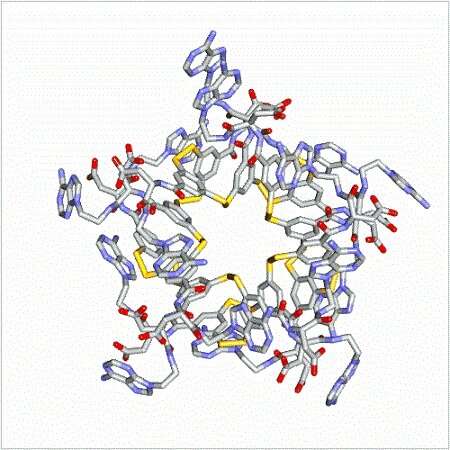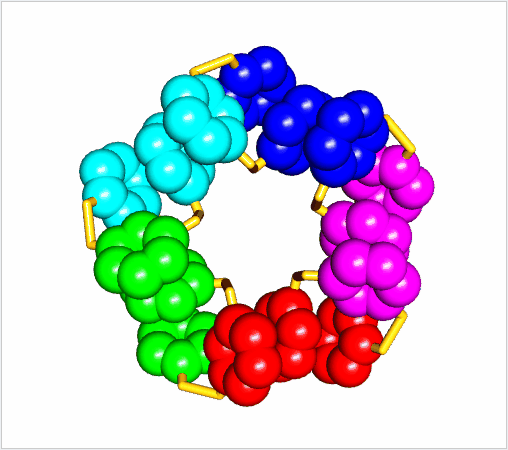Top view of the central cavity of the folded molecule. Credit: Bin Liu, University of Groningen
In biology, folded proteins are responsible for most advanced functions. These complex proteins are the result of evolution or design by scientists. Now, a team of scientists led by University of Groningen Professor of Systems Chemistry, Sijbren Otto, have discovered a new class of complex folding molecules that emerge spontaneously from simple building blocks. The results were published in the Journal of the American Chemical Society on 16 January.
A team of researchers from the Netherlands, Italy and Poland has developed a way to make complex molecules that spontaneously fold like proteins. In their paper published in the Journal of the American Chemical Society, the group describes their approach to manipulating molecules in useful ways, what they discovered, and the ways they believe their results might be used.
In nature, there are a number of proteins that fold spontaneously to carry out various functions. But misfolding can lead to problems, such as the development of neurological diseases. Scientists have been interested in such folding not only because it might help in understanding human ailments, but because it might be relevant to understanding how life began on Earth. In this new effort, the researchers sought to replicate the folding seen in nature by building their own spontaneously folding molecules.
The researchers report that they achieved their goal—they found a way to create a self-assembling, self-folding molecule called a macrocycle. More specifically, a 15mer macrocycle made up of 75 atoms. To achieve the folding, the molecule was formed in the shape of a ring. The researchers note that the end result (called a foldamer) had a hydrophilic surface and a hydrophobic core, which they note mirrors the structure of naturally occurring folding proteins. They further note that the foldamer was held together by hydrogen bonds, the interaction between ring stacking and a disulfide bridge. The molecule also had a third tiled structure made of stacks of rings.
Core part of the foldamer, showing five stacks of three phenyl rings connected by disulfide bonds. Credit: Bin Liu, University of Groningen
To induce spontaneous folding, the researchers added saltwater. They note that their molecule needed a nucleobase to form the macrocycle, but others, such as guanine or adenine, would work equally well. They next plan to work with the molecule they created to learn how to modify its self-assembly properties to create designer macrocycles in the future. They also note that their process demonstrates that folding molecules might have played a role in the beginning of life on Earth at an earlier stage than has been thought.
More information: Bin Liu et al. Complex Molecules that Fold like Proteins Can Emerge Spontaneously, Journal of the American Chemical Society (2018). DOI: 10.1021/jacs.8b11698
Journal information: Journal of the American Chemical Society
© 2019 Science X Network

























